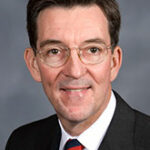By Gretchen Roberts
ST. LOUIS (July 21, 2013) — LCMS convention delegates elected five men to the offices of regional vice-presidents of The Lutheran Church—Missouri Synod, then voted to rank them as second through sixth vice-presidents. Just prior to voting, Chaplain Benjamin Ball led the convention in prayer.
Regional vice-presidents

For the West-Southwest Region: The Rev. Dr. Scott R. Murray of Houston was elected to serve on the second ballot with 600 votes, or 59.2 percent of the vote. Murray was previously fifth vice-president of the LCMS, and he has served as senior pastor at Memorial Lutheran Church and School in Houston since 1996.
Great Plains Region: The Rev. Nabil S. Nour of Armour, S.D., was elected to serve on the second ballot with 549 votes, or 60.2 percent of the vote. Nour has served as a circuit counselor, second vice-president, and first vice-president in the South Dakota District and has served as pastor of Redeemer Lutheran Church in Armour, S.D., since 1994.
Central Region: The Rev. Daniel Preus of St. Louis was elected to serve on the first ballot with 485 votes or 50.3 percent of the vote. Preus was previously fourth vice-president of the LCMS and director of the Luther Academy, and he has served as assistant pastor of Hope Lutheran Church in St. Louis since 2005.
Great Lakes Region: The Rev. Dr. John C. Wohlrabe Jr. of St. Francis, Wis., was elected to serve on the first ballot with 556 votes or 59.7 percent of the vote. Wohlrabe was previously second vice-president of the LCMS.
East-Southeast Region: The Rev. Dr. Robert T. Kuhn of Oviedo, Fla., was elected to serve on the second ballot with 471 votes or 50.9 percent of the vote. Kuhn previously served as president and first vice-president of the LCMS in 2001 and from 1995 to 2000, respectively, and on the Board of Directors of the LCMS from 2001 to 2013.
The nominations and election procedure for LCMS vice-presidents has changed as a result of the synodical restructuring recommended by a blue ribbon task force and voted in by the 2010 convention delegates, said the Rev. Dr. Raymond Hartwig, secretary of the Synod. Beginning with this 65th Regular Convention, candidates for the office of vice-president are nominated regionally, with each congregation allowed to nominate up to two candidates. Candidates must be ordained into the office of the holy ministry and living in the region from which they were nominated. Regions were drawn up geographically and are numerically balanced, although geographically some regions are much larger than others.
See a map of the regions here.
This portion of the restructuring was recommended by the Blue Ribbon Task Force on Synod Structure and Governance because vice-presidents have historically hailed primarily from the center of the country, Hartwig said. “There was interest in having representation at the synodical level from the diverse regions our Synod serves.”
Second through sixth vice-presidents
Of the five men elected to serve as regional vice-presidents, a new vote was cast to determine their ranking as LCMS vice-presidents. They are, in order:
- the Rev. Dr. John C. Wohlrabe Jr., second vice-president, with 333 votes or 31.8 percent of the vote.
- the Rev. Daniel Preus, third vice-president, with 241 votes or 23 percent of the vote.
- the Rev. Dr. Scott R. Murray, fourth vice-president, with 188 votes or 17.9 percent of the vote.
- the Rev. Nabil S. Nour, fifth vice-president, with 153 votes or 14.6 percent of the vote.
- the Rev. Dr. Robert T. Kuhn, sixth vice-president, with 133 votes or 12.7 percent of the vote.
LCMS Secretary Rev. Dr. Raymond Hartwig noted that the ranking of the vice-presidents is primarily a vote for a line of succession to the presidency, and that their duties as regional vice-presidents are largely the same.
The 65th Regular Convention of the LCMS is meeting July 20-25 at the America’s Center Convention Complex under the theme “Baptized for This Moment.” Among convention participants are 1,191 clergy and lay voting delegates.
Updated July 23, 2013
